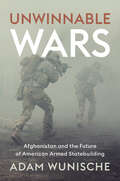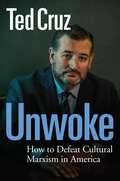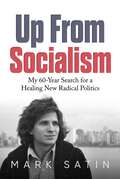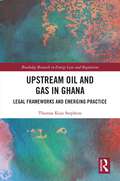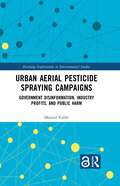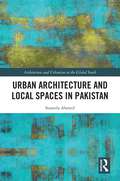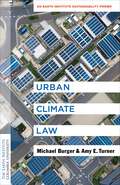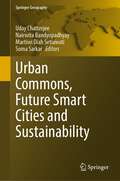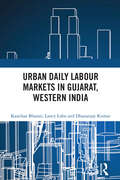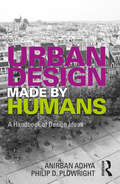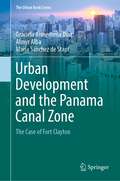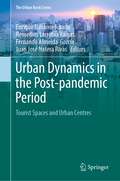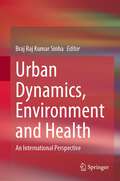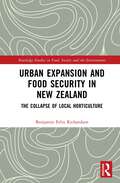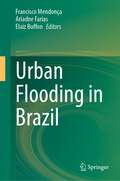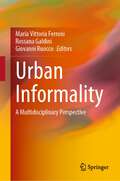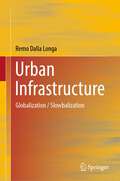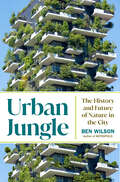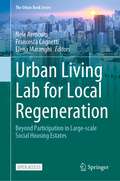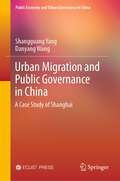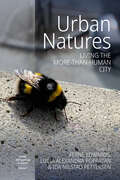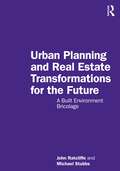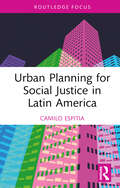- Table View
- List View
Unwinnable Wars: Afghanistan and the Future of American Armed Statebuilding
by Adam WunischeIn nine short days, Taliban forces destroyed two decades of American armed statebuilding in Afghanistan. This was no isolated failure. Over the last century, almost every attempt to intervene militarily to prop up or reconstruct an allied state has seen similar dismal outcomes. Why? This book answers that fundamental question. By exploring the factors that hindered success in Afghanistan, Adam Wunische identifies forces common to other unsuccessful U.S. armed statebuilding missions, from Vietnam to Syria, Haiti to Iraq. These forces, he argues, inherently favor insurgencies, forfeit sustainability for quick results, and create dependencies and corruption – all of which undermine the goal of building a state that can stand on its own. Not only that, but most of these forces are inescapable and uncontrollable. This means any future attempts at armed statebuilding will likely also be unwinnable, with costs and consequences far outpacing America’s interests and benefits. Faced with a future likely dominated by proxy wars, Wunische offers a novel way forward to prevent the U.S. from chasing new wars that it is destined to lose.
Unwoke: How to Defeat Cultural Marxism in America
by Ted CruzOur institutions have gone "woke." Everybody knows that. But nobody has come up with a way to stop it. Until now. <p><p> In this hard-hitting new book, Senator Ted Cruz delivers a realistic battle plan for defeating the woke assault on America. <p><p> The Democratic Party is now controlled by Cultural Marxists. So are our universities and public schools, the media, Big Tech, and Big Business. Corporations push transgenderism down their customers' throats. Banks punish gun shops. Hollywood insults our religious beliefs and grooms our children. The big investment companies use our retirement savings to promote leftist causes. And the Biden administration has turned our military into an indoctrination camp, neglected transportation safety to focus on climate change, and persecuted peaceful pro-lifers while leaving prochoice arsonists at large. <p><p> The son of Cuban immigrants who fled communist oppression, Cruz is uniquely equipped to fight the woke revolution. He eloquently explains how Cultural Marxism got a foothold in America, how it progressed, and how, in precise steps, we can fight back to regain our institutions, regain our country—and win the future for our children. <p><p> Bold, practical, and necessary, Unwoke is the book we need to restore the America we love. <p> <b>New York Times Bestseller</b>
Up From Socialism: My 60-Year Search for a Healing New Radical Politics
by Mark SatinAn essential introduction to the visionary, beyond-left-and-right political activism of the last 60 years, and a deeply honest insider account of why those activists have—so far—fallen short.&“I appreciate that Satin is willing to be so candid. It helps us all learn. And he writes in a way that touches the soul.&” —Christa Slaton, First platform coordinator for the U.S. Green Party movement, and co-editor of the book Transformational Politics: Theory, Study, and Practice In a gripping first-person narrative that reads like a novel, using his own experiences as a lens, Mark Satin tells the story of three generations of thinkers and activists who tried—and are still trying—to create a post-socialist, post-conservative, visionary and healing new politics for the U.S. In this book, Satin shows that the increasingly militant movements of the Sixties drove many young people away—and into a search for a political system and world that could work for everyone. He looks at initiatives and organizations that over the next 30 years tried to further that search, such as the New World Alliance and the early U.S. Green Party movement. Then he illuminates the 21st century turn to &“radical centrist&” and &“transpartisan&” political initiatives. Each chapter begins with a brief, context-setting introduction. Throughout the book are intense, blow-by-blow accounts of organization- and movement-building, as well as brief glimpses at over 40 often underappreciated visionary books. And always there are deeply honest accounts of Satin&’s and other activists&’ often shaky relationships with colleagues, family, and lovers—because getting healing politics right cannot be divorced from getting personal and interpersonal behavior right. You will enjoy watching Satin&’s encounters with civil rights militant Hardy Frye, Weather Underground terrorist Mark Rudd, environmental activist Paul Hawken, &“beyond GNP&” economic thinker Hazel Henderson, futurists John Naisbitt and Alvin Toffler, Nobel Peace Prize nominee Gene Sharp, Aquarian Conspiracy author Marilyn Ferguson, critical race theory co-creator Derrick Bell, radical centrist author John Avlon, and more. Nobody, least of all Satin, comes across as all-wise here, and long before this subtle and courageous book ends you will realize that a truly visionary and healing politics can only be built if we&’re willing to address all the behavioral, intellectual, organizational, and attitudinal issues this book raises.
Upstream Oil and Gas in Ghana: Legal Frameworks and Emerging Practice (Routledge Research in Energy Law and Regulation)
by Thomas Kojo StephensThis book explores the myriad issues that play out in the upstream petroleum industry of Ghana from a legal perspective. Focusing on Ghana as an emerging petroleum country, Thomas Kojo Stephens begins by examining whether the existing constitutional framework will be effective in governing the expanding oil and gas sector. Drawing on various approaches proffered by other experts in the field, Stephens looks at possible institutional structures that could be put in place and juxtaposes these ideas with the experience of Ghana to test the efficacy of these proposals. He also explores the types of contractual frameworks currently implemented in Ghana for comparison with other emerging petroleum economies, examining the barriers to effectiveness, novel provisions that must be incorporated, and lessons learned from other regions. Finally, the book highlights how vital it is for the Ghanaian State to monitor the use of petroleum revenue and make ethical investment decisions that prioritize the interests of Ghanaian citizens. Upstream Oil and Gas in Ghana will be of great interest to students and scholars of energy law and policy, oil and gas management, and African Studies more broadly, as well as those working in the upstream petroleum industry.
Urban Aerial Pesticide Spraying Campaigns: Government Disinformation, Industry Profits, and Public Harm (Routledge Explorations in Environmental Studies)
by Manuel ValléeThis book examines social processes that have contributed to growing pesticide use, with a particular focus on the role governments play in urban aerial pesticide spraying operations. Beyond being applied to sparsely populated farmland, pesticides have been increasingly used in densely populated urban environments, and when faced with invasive species, governments have resorted to large-scale aerial pesticide spraying operations in urban areas. This book focuses on New Zealand's 2002–2004 pesticide campaign to eradicate the Painted Apple Moth, which is the largest operation of its kind in world history, whether we consider its duration (29 months), its scope (at its peak the spraying zone was 10,632 hectares/26,272 acres), the number of sprayings that were administered (the pesticide was administered on 60 different days), or the number of people exposed to the spraying (190,000+). This book provides an in-depth understanding of the social processes that contributed to the incursion, why the government sought to eradicate the moth through aerial pesticide spraying, the ideological strategies they used to build and maintain public support, and why those strategies were effective. Urban Aerial Pesticide Spraying Campaigns will be of great interest to students and researchers of pesticides, environmental sociology, environmental history, environmental studies, political ecology, geography, medical sociology, and science and technology studies.
Urban Aerial Pesticide Spraying Campaigns: Government Disinformation, Industry Profits, and Public Harm (Routledge Explorations in Environmental Studies)
by Manuel ValléeThis book examines social processes that have contributed to growing pesticide use, with a particular focus on the role governments play in urban aerial pesticide spraying operations.Beyond being applied to sparsely populated farmland, pesticides have been increasingly used in densely populated urban environments, and when faced with invasive species, governments have resorted to large-scale aerial pesticide spraying operations in urban areas. This book focuses on New Zealand's 2002–2004 pesticide campaign to eradicate the Painted Apple Moth, which is the largest operation of its kind in world history, whether we consider its duration (29 months), its scope (at its peak the spraying zone was 10,632 hectares/26,272 acres), the number of sprayings that were administered (the pesticide was administered on 60 different days), or the number of people exposed to the spraying (190,000+). This book provides an in-depth understanding of the social processes that contributed to the incursion, why the government sought to eradicate the moth through aerial pesticide spraying, the ideological strategies they used to build and maintain public support, and why those strategies were effective.Urban Aerial Pesticide Spraying Campaigns will be of great interest to students and researchers of pesticides, environmental sociology, environmental history, environmental studies, political ecology, geography, medical sociology, and science and technology studies.The Open Access version of this book, available at http://www.taylorfrancis.com, has been made available under a Creative Commons Attribution-Non Commercial-No Derivatives (CC-BY-NC-ND) 4.0 license.
Urban Architecture and Local Spaces in Pakistan (Architecture and Urbanism in the Global South)
by Suneela AhmedThis book is set in Karachi, Pakistan and investigates the possibility of achieving localness through identifying urban process and their impact on built form, addressing how locals associate with the urban spaces and how they value it. Thus, the investigation, using the local terminology maqamiat, goes beyond the physicality of space and develops a framework that helps to understand the social, ethnic, economic, ecological and other the non-physical aspects of space, which are of value to the locals. The aim is to investigate the possibility of achieving localness through identifying urban design elements that can be incorporated into the process of designing new built forms that acknowledges what is valued by the locals instead of superimposing imported designs, negating the contextual realties, both physical and social. For this purpose, the book includes three case studies from Karachi. The book questions the aspiration of many cities in the South Asian context to imitate the built forms of Western cities (increasingly, Singapore and Shanghai) which are viewed as modern and represents future. The book will make a theoretical contribution to the existing literature on postcolonial urbanism and explore space from a local vantage point for understanding how to look inwards for aspiration.
Urban Climate Law: An Earth Institute Sustainability Primer (Columbia University Earth Institute Sustainability Primers)
by Michael Burger Amy E. TurnerCities have taken a leading role in efforts to reduce greenhouse gas emissions. As federal and state climate policy waxes and wanes, many of the largest U.S. cities have pledged themselves to ambitious sustainability goals, as have smaller communities across the country. City-level policy makers, facing a range of political constraints, a thicket of federal and state laws, and varying degrees of municipal authority, need to figure out how to meet their climate commitments.Urban Climate Law is a practical, user-friendly primer on the legal challenges and opportunities for effective and equitable decarbonization. Michael Burger and Amy E. Turner—leading experts in local climate law and policy—examine the key issues surrounding climate mitigation policies across the buildings, transportation, waste, and energy sectors, with an emphasis on environmental justice. They explore the legal frameworks and factors that can constrain or enable various approaches at the municipal level. Burger and Turner clearly and accessibly present complex legal topics like preemption, federal statutes such as the Clean Air Act, and constitutional law for readers without legal backgrounds, including students, advocates, officials, and other practitioners. Aimed at a nonspecialist audience, this book provides concise and comprehensible answers to the core questions cities confront when seeking to develop legally sound local climate policy.
Urban Commons, Future Smart Cities and Sustainability (Springer Geography)
by Uday Chatterjee Nairwita Bandyopadhyay Martiwi Diah Setiawati Soma SarkarThis book provides a critical theoretical framework for understanding the implementation and development of smart cities as innovation drivers, with long-term effects on productivity, livability, and the sustainability of specific initiatives. This framework is based on an empirical analysis of 21 case studies, which include pioneer projects from various regions. It investigates how successful smart city initiatives foster technological innovation by combining regulatory governance and private agency. The typologies of smart city-making approaches are thoroughly examined. This book presents the holistic approach of smart cities, which start from current issue and challenges, advanced technological development, disaster mitigation, ecological perspective, social issue, and urban governance. The book is organized into five major parts, which reflect interconnection between theories and practice. Part one explains the introduction which reflects the diversity and challenges of the urban commons and its regeneration. Part two covers the current and future situation of urban growth, anglomeration agglomeration, and urban infrastructure. This section includes rethinking urban sprawl: moving towards sustainable cities, drivers of urban growth and infrastructure, urban land use dynamics and urban sprawl and urban infrastructure sustainability and resilience. Part three describes climate crisis, urban health, and waste management. This section includes climate change and health impacts in urban areas, green spaces: an invaluable resource for delivering sustainable urban health, health and wellbeing and quality of life in the changing urban environment, urban climate and pollution—case study, sustainable urban waste management and urban sustainability and global warming and urban heat Island. Part four covers the ecological perspectives, advanced technology, and social impact for i.e., smart building, ecosystem services, society and future smart cities (SSC). This section includes urban ecosystem services, environmental planning, and city management, artificial intelligence and urban hazards and societal impact, and using geospatial application and urban/smart city energy conservation—case study. Part five covers urban governance, smart solutions, and sustainable cities. It includes good governance, especially e-governance and citizen participation, urban governance, space and policy planning to achieve sustainability, smart city planning and management and Internet of things (IoT), advances in smart roads for future smart cities, sustainable city planning, innovation, and management, future strategy for sustainable smart cities and lessons from the pandemic: the future of smart cities.
Urban Daily Labour Markets in Gujarat, Western India
by Dhananjay Kumar Kanchan Bharati LANCY LOBOThis volume explores one of the most complex labour landscapes of India - the urban daily labour market. These markets form an important sector of the urban informal labour market and contribute significantly to the Indian economy. This book presents an empirical, comparative picture of daily labour markets, in Gujarat, Western India. These markets consist mostly of intra-state and interstate migrant workers who suffer from layered multiple marginalities based on markers of informality, migrant status, caste, ethnicity, gender and poor agency and often live in the peripheries of the cities without any rights and entitlements to their spaces and services. This study, based on an extensive survey of three cities in Gujarat, contains descriptions and analyses of the places of migration and their causes as well as the working and living conditions of the workers along with their spending patterns on food, health, education and leisure. It mirrors the work, life and issues of these workers on the regional level while contributing to a better understanding for future policy interventions. An in-depth study, the book will be of interest to students and researchers of labour economics, labour studies, urban planning, social work, sociology, anthropology, and demography. It will also be useful to NGOs/trade unions working with migrant workers, civil servants in Labour department and other related departments, city planners and policy makers.
Urban Design Made by Humans: A Handbook of Design Ideas
by Anirban Adhya Philip D. PlowrightThe design of urban environments is complex and involves diverse needs, organisations, professions, authorities, and communities. It requires relationships to be constructed and sustained between infrastructure, resources, and populations across multiple scales. This can be quite daunting. However, at the core of urban design is a simple idea—our urban spaces are designed to allow people and communities to thrive. For that reason, a good starting point for urban designers is to focus on the way people think when engaging our built environment. This thinking is embodied, developed through the interactions between our mind, body, and the environment around us. These embodied concepts are central to how we see the world, how we move and gather, and how we interact with others. They are also the same ideas we use to design our environments and cities. Urban Design Made by Humans is a reference book that presents 56 concepts, notions, ideas, and agreements fundamental to the design and interpretation of our human settlements. The ideas here parallel those found in Making Architecture Through Being Human but extends them into urban environments. Urban Design Made by Humans distinctly highlights priorities in urban design in how we produce meaningful environments catering to wider groups of people. Each idea is isolated for clarity with short and concise definitions, examples, and illustrations. They are organised in five sections of increasing complexity. Taken as a whole, the entries frame the priorities and values of urban design while also being instances of a larger system of human thinking.
Urban Development and the Panama Canal Zone: The Case of Fort Clayton (The Urban Book Series)
by Graciela Arosemena Díaz Almyr Alba María Sánchez StapfThe construction of the Panama Canal at the beginning of the twentieth century created an enclave that ran parallel to the interoceanic waterway, controlled by the US government: the Canal Zone. This book aims to understand the implications that Panama Canal Zone urban planning had on human health, natural resources, and biodiversity through the study case of Fort Clayton, highlighting how the sanitary concerns shaped building regulations and the urban landscape of towns.This book highlights the role of North American entomologists and health workers in developing control strategies for diseases transmitted by mosquitoes and how mosquito’s ecology determined building regulations that shaped the image of the Canal Zone towns. On the other hand, the book determines the environmental assessment of Fort Clayton, determined by the two fundamental aspects that set on the environmental impact of an urban settlement. The first one is the suitability of the site's location. The second is the urban structure of the adopted city model and its impact on the connectivity of the surrounding forests during the twentieth century.This text is aimed at both undergraduate and postgraduate students, architects, urban planners, historians, and environmental science professionals.
Urban Dynamics in the Post-pandemic Period: Tourist Spaces and Urban Centres (The Urban Book Series)
by Enrique Navarro-Jurado Remedios Larrubia Vargas Fernando Almeida-García Juan José Natera RivasThis book offers a unique perspective on urban processes affecting tourist spaces and city centres. Economic, social and environmental uncertainty has been commonplace since March 2019, when mobility slowed down across the globe. The COVID-19 pandemic accelerated trends that have been investigated in urban space for years. The incorporation of technologies, the expansion of tourism and the introduction of policies that in part want to advance sustainability are generating processes of reorganisation of territories that are driving changes. These changes will affect models of city, urbanism and society.This publication is directed to a wide spectrum of people interested in urban processes, tourism and social change in the context of the Post-Pandemic Covid-19. In particular, the book is aimed at researchers, undergraduate and postgraduate students, consultants, public administrations and the public interested in the recent challenges that are affecting developed and developing societies.
Urban Dynamics, Environment and Health: An International Perspective
by Braj Raj Kumar SinhaThe comprehensive volume focuses on spatial, temporal, conceptual and empirical approaches to various elements of urban dynamics, environment and urban health. It demonstrates a multidisciplinary account of the significant dimensions of urbanization and urban life. Chapters by leading international experts are presented in sections on urban dynamics, Urban Environmental Issues, Urban Health Problems and Urban Development, Planning and Policies. Each chapter provides a breadth of information on conceptual and empirical studies of urban issues. It enables the readers to understand the interconnections of various vital elements of each urban-related topical issue locally, regionally and globally. Extensive maps, charts, diagrams and tables as cartographic tools facilitate the reader’s understanding. It also outlines an action plan for policy program change in both the developed and less developed countries toward sustainable urban development and environment for better health, prosperity and quality of life of the present and future urban population. It is an indispensable reference for students, research scholars of geography and environmental, medical, and social sciences at undergraduate and postgraduate levels.
Urban Expansion and Food Security in New Zealand: The Collapse of Local Horticulture (Routledge Studies in Food, Society and the Environment)
by Benjamin Felix RichardsonThis book examines suburban development in New Zealand and its conflict with and impact on local horticulture and food security. Drawing on an ethnographic study of Auckland’s rapidly expanding urban periphery, combined with comparative case studies from California in the USA and Victoria in Australia, the book examines how the profit-making strategies of property developers and landowners drastically reshapes work and life at the edge of cities. With a significant portion of the world's croplands lying adjacent to cities, the accelerating pace of urban sprawl across the planet places unprecedented pressure on the productivity and even existence of these vital food bowl regions. The book examines how the demand for more land for development at the urban periphery collides with concerns over local food security and the protection of ecosystem services. It analyses land use policy, historical records, and physical patterns of development, alongside participant observation of local events. It combines this with interviews with government officials, property developers, landowners, local residents and horticulturists. By combining these narratives of the hectic and lucrative business of suburban property development with the collapse of local horticulture, this book shows how the realignment of the New Zealand's interests of financial profitability over other concerns led to the transformation of urban peripheries from a productive food bowl to an investment vehicle. This book will be of great interest to students and scholars of urban food and agriculture, urban planning and development and rural-urban studies.
Urban Flooding in Brazil
by Francisco Mendonça Ariadne Farias Elaiz BuffonThis contributed volume analyzes flooding scenarios in Brazilian cities using a geographic and spatiotemporal approach to explore impacts and ways to mitigate future disasters. The problem of urban flooding is growing in Brazilian cities due to the increasing number of natural disasters in the context of global climate change; this is a topic that poses challenges to urban planners and academics. Through three sections, this volume offers theoretical-conceptual, methodological and technical case studies, as well as cases that explore urban socio-environmental problems associated with flooding. Throughout the book, the concepts of risk, vulnerability and adaptation are used to explore future flood scenarios in Brazil.The integrated vision offered in this volume covers the floods themselves, evaluation of flood impacts, and the management process before, during, and after the flood event. The case studies presented here elucidate the concept of comprehensive urban flood management, offering a technical and diagnostic basis for the problem in different cities in Brazil. The present and future challenges presented by these chapters offer widely-transferable lessons that can be applied to making cities around the world more sustainable and disaster-resilient.
Urban Informality: A Multidisciplinary Perspective
by Maria Vittoria Ferroni Rossana Galdini Giovanni RuoccoThis book analyzes the informal practices of contemporary cities through a close dialogue between different research perspectives, with the shared goal of giving voice to informality and evaluating its benefits and potential in a multidimensional key of social factors. Recently, the human sciences have seen the emergence of this new term “informality,” at first sight in conflict with their function of giving order and form to social phenomena. A term with which, in this book, the authors, having as reference the Italian and European experience, specifically identify those unsatisfied social demands and those collective actions “from below” that aim at the recovery of urban space and the renewal of its organization, often not following the trajectories of legality and institutions. By means of a close dialogue between different areas of social research, this book attempts to establish the different declinations and applications of the term, evaluating the causes and effects, benefits, and potential of the phenomena attributable to it, within a multidimensional analysis that calls into question the regeneration and collective use of spaces, political-institutional confrontation and conflict, legal innovation, and social-economic benefits.
Urban Infrastructure: Globalization / Slowbalization
by Remo Dalla LongaThe book deals with the concept of urban infrastructure and the strong evolution of globalization, in particular the driving force taken by global cities. Urban infrastructure is a constituent part of the global cities, both have a synergistic evolution. The main reference is to western global cities in the intertwining of financialization, settling and brownfield which is a little different from the urbanization of other global cities of other non- developed countries, or emerging countries. There is therefore a significant link between globalization and urban infrastructure. The occurrence of slowbalization can have consequences on urban areas infrastructures and more generally on the different dichotomy between global city and nation. With the pandemic infectious and the post COVID, there is already a different configuration between the global city and the rest of the national territory. A driving element of the urban infrastructure and the global city has been the financialization and identification of assets within global cities. Urban infrastructure as an asset has grown considerably in the last two decades, in the wake of what has already been highlighted previously for real estate. There are contiguous issues that affect the concept of urban infrastructures and they are the enormous growth of finance and the landings of this in the great cities of the world with investments that first involved Real Estate and then urban infrastructures. There has also been a technological revolution that has merged the ubiquitous technological infrastructure with other more traditional components of the infrastructure, even apparently recent themes, such as smart cities, come from this evolutionary trend and merge with urban infrastructures. The theme of smart cities, if properly interpreted, gives strength to the concept of urban infrastructure.
Urban Jungle: The History and Future of Nature in the City
by Ben WilsonIn this exhilarating look at cities, past and future, Ben Wilson proposes that, in our world of rising seas and threatening weather, the natural world may prove the city's savior.Since the beginning of civilization, humans have built cities to wall nature out, then glorified it in beloved but quite artificial parks. In Urban Jungle Ben Wilson—the author of Metropolis, a seven-thousand-year history of cities that the Wall Street Journal called &“a towering achievement&”—looks to the fraught relationship between nature and the city for clues to how the planet can survive in an age of climate crisis.Whether it was the market farmers of Paris, Germans in medieval forest cities, or the Aztecs in the floating city of Tenochtitlan, pre-modern humans had an essential bond with nature. But when the day came that water was piped in and food flown from distant fields, that relationship was lost. Today, urban areas are the fastest-growing habitat on Earth and in Urban Jungle Ben Wilson finds that we are at last acknowledging that human engineering is not enough to protect us from extremes of weather. He takes us to places where efforts to rewild the city are under way: to Los Angeles, where the city&’s concrete river will run blue again, to New York City, where a bleak landfill will be a vast grassland preserve. The pinnacle of this strategy will be Amsterdam: a city that is its own ecosystem, that makes no waste and produces its own energy. In many cities, Wilson finds, nature is already thriving. Koalas are settling in Brisbane, wild boar may raid your picnic in Berlin. Green canopies, wildflowers, wildlife: the things that will help cities survive, he notes, also make people happy.Urban Jungle offers the pleasures of history—how backyard gardens spread exotic species all over the world, how war produces biodiversity—alongside a fantastic vision of the lush green cities of our future. Climate change, Ben Wilson believes, is only the latest chapter in the dramatic human story of nature and the city.
Urban Living Lab for Local Regeneration: Beyond Participation in Large-scale Social Housing Estates (The Urban Book Series)
by Nele Aernouts Francesca Cognetti Elena MaranghiThis open access book provides an integrated overview of the challenges and resources of large-scale social housing estates in Europe and outlines possible interdisciplinary approaches and tools to promote their regeneration. It especially focuses on the tool of urban living labs, as promising in promoting new and more effective local governance and in including the different actors into the planning process. The book combines theory and practice, since it is the result of action-research conducted in different social housing estates all over Europe.Building on the results of the SoHoLab project (2017–2020), the book benefits from a multidisciplinary perspective, since the researchers involved belong to the fields of anthropology, urban planning, architecture, urban sociology. The project combined theoretical reflections with the installation and/or the consolidation of Urban Living Labs, run by universities, in large social housing estates in three European cities: Brussels, Milan and Paris.
Urban Migration and Public Governance in China: A Case Study of Shanghai (Public Economy and Urban Governance in China)
by Shangguang Yang Danyang WangThis book, focusing on urban migration and public governance, reviews on the concepts and theories of urban migration and urban governance across the globe and sums up world migration trends and policy changes, coupled with the characteristics and types of China’s urban migration. What differs this book from other books is that it probes into the main factors and mechanisms influencing urban migration and inclusion, and that it adopts Shanghai as a sample and capitalizes on Shanghai’s urban migration data to verify the subjective and objective reasons affecting urban migrants’ inclusion. Moreover, this book takes a further step to conduct a theoretical reflection from the perspectives of population migration and migration policies and explores current dilemmas facing China in terms of urban migration management and possible ways to make a difference. In the final part, this book puts forward some theory-based and practicable countermeasures to transform urban migration governance in China.
Urban Natures: Living the More-than-Human City (Urban Anthropology Unbound #1)
by Ida Nilstad Pettersen Ferne Edwards, Lucia Alexandra PopartanEfforts to create greener urban spaces have historically taken many forms, often disorganized and undisciplined. Recently, however, the push towards greener cities has evolved into a more cohesive movement. Drawing from multidisciplinary case studies, Urban Natures examines the possibilities of an ethical lively multi-species city with the understanding that humanity’s relationship to nature is politically constructed. Covering a wide range of sectors, cities, and urban spaces, as well as topics ranging from edible cities to issues of power, and more-than-human methodologies, this volume pushes our imagination of a green urban future.
Urban Planning and Real Estate Transformations for the Future: A Built Environment Bricolage
by John Ratcliffe Michael StubbsThis book presents fresh ways of thinking about the future for all those involved in conceiving, planning, designing, funding, constructing, occupying and managing the built environment, to face the challenges, and grasp the opportunities, that lie ahead over the next few decades. Four major themes form the basis of the volume: (1) Future Awareness and a New Sense of Place. (2) Global Governance and Anticipatory Leadership. (3) Innovation, Reform and Exemplars. (4) Urban Planning and Real Estate Transformations. Within these structural themes are a diverse range of 'Discourses' addressing many of the big questions and driving forces that face us, together with a proposed methodology (Strategic Foresight) and an array of practical illustrations viewing what can be done today – whether by organisations, individuals, cities or communities – to positively shape a preferred future and manipulate us towards achieving it. It will be important reading for students, practitioners, agencies and corporations across the built environment, especially in the fields of urban planning, real estate development, architecture, civil engineering and construction.
Urban Planning and Real Estate Transformations for the Future: A Built Environment Bricolage
by John Ratcliffe Michael StubbsThis book presents fresh ways of thinking about the future for all those involved in conceiving, planning, designing, funding, constructing, occupying and managing the built environment, to face the challenges, and grasp the opportunities, that lie ahead over the next few decades. Four major themes form the basis of the volume:(1) Future Awareness and a New Sense of Place.(2) Global Governance and Anticipatory Leadership. (3) Innovation, Reform and Exemplars. (4) Urban Planning and Real Estate Transformations. Within these structural themes are a diverse range of 'Discourses' addressing many of the big questions and driving forces that face us, together with a proposed methodology (Strategic Foresight) and an array of practical illustrations viewing what can be done today – whether by organisations, individuals, cities or communities – to positively shape a preferred future and manipulate us towards achieving it. It will be important reading for students, practitioners, agencies and corporations across the built environment, especially in the fields of urban planning, real estate development, architecture, civil engineering and construction.
Urban Planning for Social Justice in Latin America
by Camilo EspitiaUrban Planning for Social Justice in Latin America explores how urban planning can be used as a tool for social equity. The book examines several Latin American cities, each with specific challenges, and explores how they have gradually overcome these difficulties through policies, planning, and design, and with private/public sector coordination. The cases include: The built environment and social mobility in Bogotá; Mexico City and its difficulties with water scarcity; Addressing air quality and environmental justice in Lima; Santiago de Chile’s energy consumption and carbon footprint; Buenos Aires and the issue of urban agriculture and food security; Connectivity as a social transformation device in Medellín. The book goes beyond simply identifying the challenges and explains some of the practical day-to-day planning efforts, including interviews with staff from those municipalities, illustrations, and strategies that have been successful. As a result, this book will be helpful to planners in the region, as well as outside Latin America, because it demonstrates how fruitful results can be achieved in areas typically perceived as underdeveloped. Although based on research and data, this book offers a positive perspective on the possibilities rather than the limitations, hoping to inspire new generations of planners to pursue careers in search of social change.
